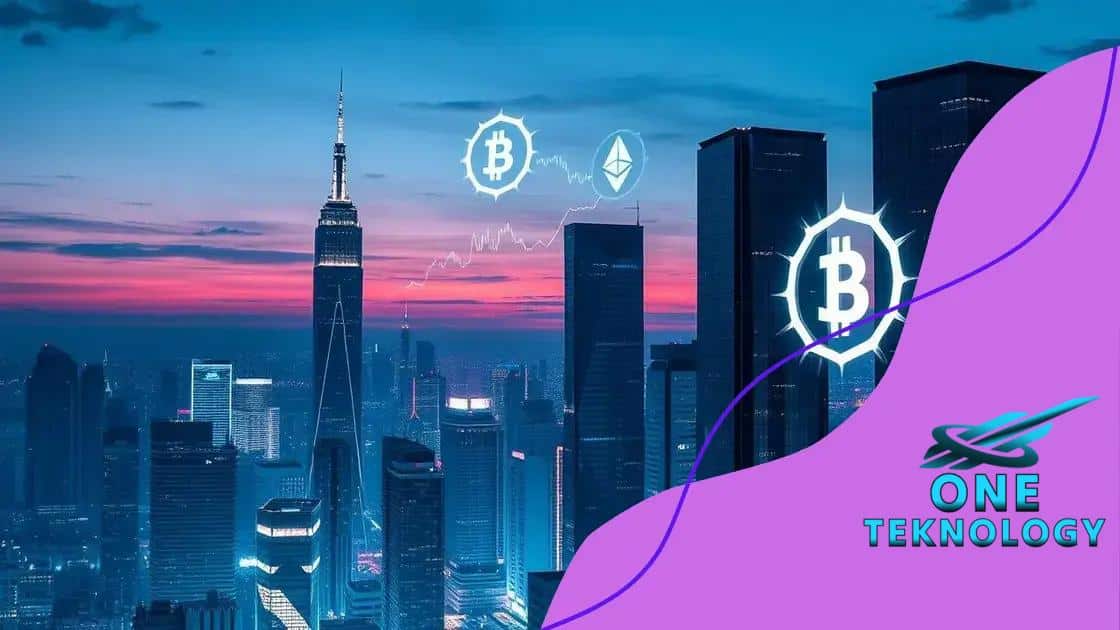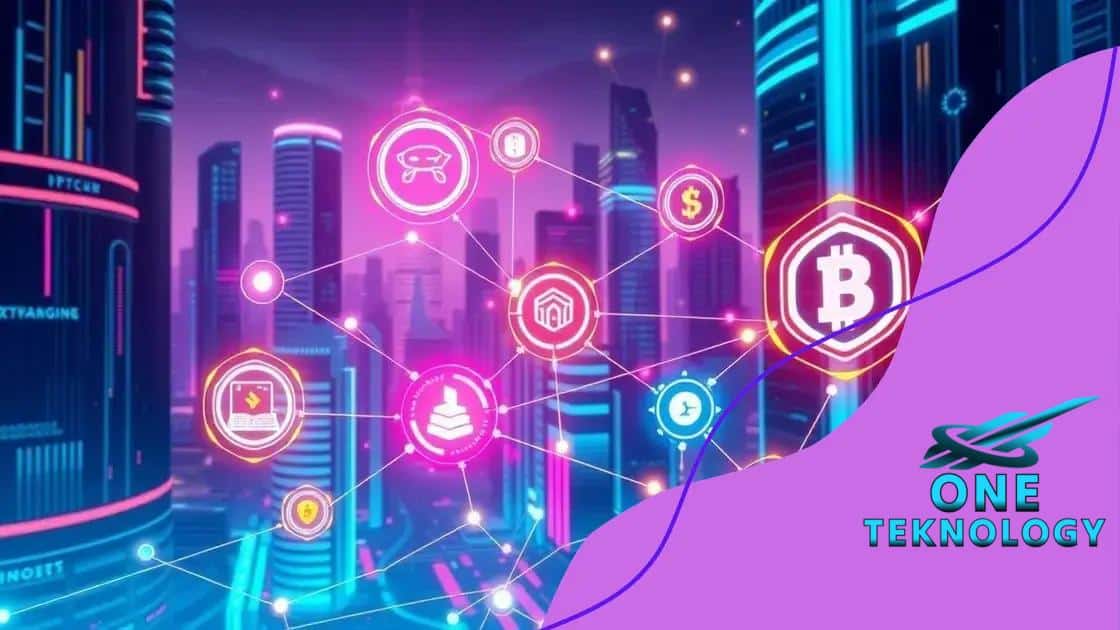The role of decentralized finance (DeFi) in global markets

The role of decentralized finance (DeFi) in global markets is to provide accessible financial services without intermediaries, reducing costs and increasing transparency while presenting risks like market volatility and smart contract vulnerabilities.
The role of decentralized finance (DeFi) in global markets is reshaping how we think about finance. Have you considered how it can impact your investments or daily transactions? Let’s dive deeper into this emerging landscape.
Understanding decentralized finance (DeFi)
Understanding decentralized finance (DeFi) is crucial in today’s financial landscape. DeFi represents a new way of thinking about money and financial systems, allowing users to access services without traditional intermediaries.
What is DeFi?
At its core, DeFi uses blockchain technology to create financial products and services that are open, permissionless, and transparent. Unlike conventional finance, DeFi allows anyone with an internet connection to participate.
Through smart contracts, users can lend, borrow, and earn interest on their assets without needing banks. This system promotes accessibility and reduces costs.
Key Features of DeFi
- Accessibility: No barriers to entry, as anyone can access DeFi platforms.
- Transparency: All transactions are recorded on the blockchain, which enhances trust.
- Control: Users have full control over their funds, eliminating the need for banks.
- Innovation: DeFi encourages new financial products and services to emerge.
In addition to these features, DeFi platforms often operate around the clock, giving users flexibility and efficiency. This means you can trade or lend at any time, enhancing the user experience significantly.
The integration of decentralized applications (dApps) makes DeFi even more attractive. dApps offer various services, from trading to insurance, all on a blockchain. This multi-functionality creates a vibrant ecosystem where users can explore different financial options without regulatory constraints.
As you can see, understanding decentralized finance (DeFi) is not just about grasping its definition, but also about recognizing its impact on global finance. With its growing adoption, there lies a fascinating world that is reshaping traditional banking and investment opportunities.
Key advantages of DeFi in global finance
The key advantages of DeFi in global finance offer exciting prospects for individuals and businesses. With traditional financial systems often limited by regulations, decentralized finance provides an alternative that emphasizes inclusivity and efficiency.
Lower Costs
One significant advantage of DeFi is the reduction in transaction costs. By eliminating middlemen, users can engage directly with financial services. This means lower fees for transactions, lending, and trading. As a result, many users find they can save money while maximizing their returns.
Increased Accessibility
DeFi platforms are accessible globally, allowing anyone with internet access to participate. This aspect of decentralized finance breaks down barriers faced by people in unbanked regions. Individuals no longer need a bank account to access financial products.
- Anyone can open a DeFi account, regardless of geographic location.
- No strict KYC (Know Your Customer) processes are required.
- Access to financial services is open 24/7.
By utilizing blockchain technology, DeFi ensures transparency across all transactions. Users can track their funds and audit the systems, fostering trust within the community. This increased transparency is essential in mitigating fraud and improving confidence among users.
Innovation and Customization
The DeFi ecosystem encourages innovation, providing tools for developers to create new financial products. These innovations include stablecoins, lending protocols, and decentralized exchanges. Users benefit from a greater variety of services tailored to their specific needs.
Additionally, DeFi offers users the opportunity to customize their financial strategies. By utilizing various protocols, they can optimize their investments, access yield farming, and construct personalized portfolios tailored to their risk tolerance.
In summary, the key advantages of DeFi in global finance revolve around decreased costs, increased accessibility, transparency, and ongoing innovation. These factors combine to form a compelling argument for those looking to participate in the future of finance.
Real-world examples of DeFi applications

Exploring real-world examples of DeFi applications reveals how decentralized finance is transforming various sectors. These innovative platforms are redefining how we think about investment, lending, and trade.
Decentralized Exchanges (DEX)
One of the most visible applications of DeFi is through decentralized exchanges. Platforms like Uniswap and SushiSwap allow users to trade tokens directly without intermediaries. This not only increases liquidity but also lowers transaction costs. Users can trade freely, which is a significant shift from traditional centralized exchanges.
Lending and Borrowing Protocols
Another prominent example is lending and borrowing platforms such as Aave and Compound. These protocols enable users to lend their assets and earn interest. Conversely, borrowers can take out loans by providing collateral. This process is automated through smart contracts, meaning transactions can occur seamlessly and quickly.
- Aave: Offers flash loans, allowing users to borrow funds for a very short term.
- Compound: Enables users to earn interest on their deposits and borrow assets as needed.
- Yearn Finance: Optimizes yield farming, helping users find the best rates.
Additionally, DeFi has introduced stablecoins like DAI and USDC. These digital assets are pegged to traditional currencies, providing stability in the often volatile crypto market. Users can transact with confidence, knowing their value will remain relatively constant.
Insurance Solutions
Insurance is another area being revolutionized by DeFi. Platforms such as Nexus Mutual allow users to pool their funds to cover risks collectively. This peer-to-peer model gives users control over their insurance policies while reducing costs compared to traditional insurance.
These examples illustrate how real-world DeFi applications are not just theoretical concepts. They highlight practical solutions that offer democratized financial services, greater accessibility, and innovative product offerings. Users see the impact on their daily lives, from trading to borrowing, making DeFi a sector worth following closely.
Challenges and risks of DeFi systems
While decentralized finance (DeFi) offers numerous benefits, it also comes with its share of challenges and risks. Understanding these can help users make informed decisions in this evolving landscape.
Smart Contract Vulnerabilities
One of the primary risks involves smart contracts. These self-executing agreements are designed to automate transactions. However, if they contain coding errors or vulnerabilities, hackers can exploit them, leading to significant financial losses. Many users have lost funds in high-profile hacks, raising concerns about security.
Market Volatility
DeFi projects are often tied to cryptocurrencies, which are known for their price volatility. This volatility can significantly impact the value of assets held within DeFi protocols. Users may face rapid losses as market conditions change unpredictably. For instance, an asset may lose its value quickly, affecting loans or collateral values.
- The rapid rise and fall of cryptocurrency prices can lead to liquidations.
- Users may experience significant fluctuations in their returns.
- Market manipulation can lead to sudden price spikes or drops.
Another challenge is regulatory uncertainty. Since DeFi operates outside traditional financial systems, it often lacks oversight. While this allows for innovation, it also raises questions about how governments will regulate these platforms. Users might face unexpected legal challenges if regulations change or new laws are enacted.
Liquidity Risks
Liquidity is essential for DeFi platforms to function smoothly. If there are not enough buyers or sellers, transactions can become challenging. Users might find it hard to withdraw their funds during market downturns, trapping their assets within the platform.
Additionally, with numerous DeFi platforms emerging, assessing which ones are reliable can be tough. Not all platforms have proven track records. Users must conduct thorough research before engaging with any DeFi service to minimize risks.
In summary, while decentralized finance has the potential to revolutionize the financial industry, users must remain aware of the challenges and risks involved. By understanding these issues, they can better navigate the DeFi space and make more informed decisions.
The future of DeFi in the global market
The future of DeFi in the global market looks promising as it continues to evolve and influence traditional financial systems. As more people become aware of decentralized finance, the demand for these services is likely to grow significantly.
Integration with Traditional Finance
One key aspect of the future of DeFi is its potential integration with traditional financial institutions. As banks and other financial entities recognize the benefits of DeFi, they may start to adopt blockchain technology. This could lead to hybrid financial systems that blend the best of both worlds, allowing for faster, cheaper, and more accessible services.
Increased Regulation
As DeFi continues to expand, regulatory scrutiny will likely increase. Governments around the world are beginning to understand decentralized finance and its implications. Future regulations will aim to protect consumers while encouraging innovation. Striking the right balance will be essential for the sustainable growth of the DeFi ecosystem.
- Clear regulatory frameworks can build trust with users.
- Regulations may help prevent fraud and protect investments.
- Standardized practices can create a safer environment for all participants.
The advancement of technology will also play a central role in the future of DeFi. Improvements in blockchain technology can lead to faster transaction speeds and lower fees. As the technology matures, we can expect more user-friendly interfaces that simplify DeFi interactions. This will help onboard more people into the DeFi space, making it accessible to a broader audience.
Innovative Financial Products
With ongoing innovation, new financial products are likely to emerge within DeFi. We may see advanced derivatives, insurance models, and lending protocols that utilize artificial intelligence to optimize user experiences. The potential for creativity in product offerings will attract more users and investors.
As we look ahead, the intersection of DeFi and digital identities might also reshape user engagement. Secure digital identities can streamline onboarding processes and enhance security measures, making it easier for users to manage their finances.
Ultimately, the future of DeFi in the global market is intertwined with how quickly it can adapt, innovate, and respond to user needs. As more individuals and institutions embrace decentralized finance, the market will likely see continued growth and transformation.
FAQ – Frequently Asked Questions about Decentralized Finance (DeFi)
What is decentralized finance (DeFi)?
DeFi refers to a financial system that operates on blockchain technology, allowing users to access services without traditional intermediaries like banks.
What are the main advantages of using DeFi?
The main advantages include lower transaction costs, increased accessibility to financial services, and greater transparency in transactions.
What are the risks associated with DeFi?
Risks include smart contract vulnerabilities, market volatility, and regulatory uncertainties that can affect users’ investments.
How does DeFi integrate with traditional finance?
DeFi can integrate with traditional finance by allowing banks to adopt blockchain technology, creating a more efficient financial system that combines the strengths of both.






